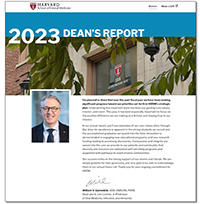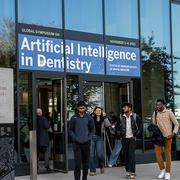
In dental research and practice, all eyes are on artificial intelligence's (AI) promise for patients.
AI has made its arrival in dental care around the world, largely thanks to a swell of early adopters who have embraced the newest assistive technologies that could lead to earlier diagnosis of oral diseases and put more informative tools in the hands of patients. Now, the majority of dental practices, dental schools, oral health researchers, and policymakers are rapidly positioning themselves to evolve in step with the dawning AI movement in oral healthcare.
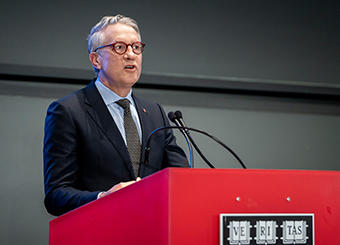 “AI holds the promise of transforming the way we practice oral healthcare, pinpoint and treat diseases and conditions, and increase equitable access to care and treatment,” said William Giannobile, dean of Harvard School of Dental Medicine (HSDM), during his opening remarks at HSDM’s inaugural Global Symposium on AI and Dentistry, held November 3-4, 2023 in Boston.
“AI holds the promise of transforming the way we practice oral healthcare, pinpoint and treat diseases and conditions, and increase equitable access to care and treatment,” said William Giannobile, dean of Harvard School of Dental Medicine (HSDM), during his opening remarks at HSDM’s inaugural Global Symposium on AI and Dentistry, held November 3-4, 2023 in Boston.
The tangible energy around AI’s growing influence on dentistry is what prompted HSDM to gather more than 400 leading dental practitioners, researchers, students, AI scientists, ethicists, and policymakers from 30 countries around the globe — 300 attendees joined the symposium in person and another 120 tuned in virtually to the event’s workshops, keynotes, and thematic panel discussions.
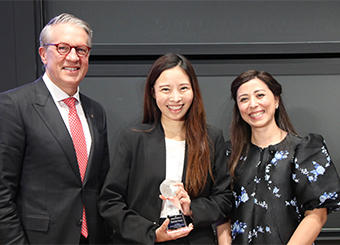 More than 65 research projects were presented during the symposium’s poster session, featuring a range of device prototypes, patient-facing smartphone apps, and other technologies under development at the intersection of AI and dentistry. A panel of judges honored several poster presenters, including second-place prize winner Dahee Chung, an HSDM student who described her research to develop an AI-based module for tooth prognosis, clinical decisions, and treatment plans based on patient medical and social history, x-ray findings, and other parameters.
More than 65 research projects were presented during the symposium’s poster session, featuring a range of device prototypes, patient-facing smartphone apps, and other technologies under development at the intersection of AI and dentistry. A panel of judges honored several poster presenters, including second-place prize winner Dahee Chung, an HSDM student who described her research to develop an AI-based module for tooth prognosis, clinical decisions, and treatment plans based on patient medical and social history, x-ray findings, and other parameters.
Harnessing AI to Address Barriers in Oral Healthcare
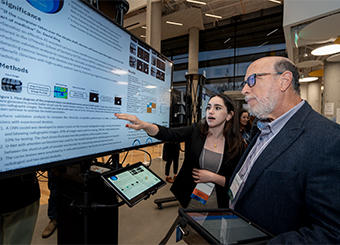 For more than 40 years, researchers have been experimenting with ways to apply AI to dentistry, said Florian Hillen, founder and CEO of VideaHealth, a dental imaging startup launched from AI research conducted at Harvard and MIT. Within the last decade, AI capabilities have finally reached critical mass. “AI-powered tools are now helping dentists identify dental decay in patients up to five years earlier…. the tech revolution is happening,” he said.
For more than 40 years, researchers have been experimenting with ways to apply AI to dentistry, said Florian Hillen, founder and CEO of VideaHealth, a dental imaging startup launched from AI research conducted at Harvard and MIT. Within the last decade, AI capabilities have finally reached critical mass. “AI-powered tools are now helping dentists identify dental decay in patients up to five years earlier…. the tech revolution is happening,” he said.
Beyond opportunities to improve outcomes for individual patients, researchers are quickly seizing AI to help solve population-level health challenges. But for AI to effectively tackle large-scale problems, academia and industry will have to dissolve the boundaries between different scientific disciplines, said Dimitrias Bertsimas of Massachusetts Institute of Technology (MIT), one of the symposium’s keynote speakers.
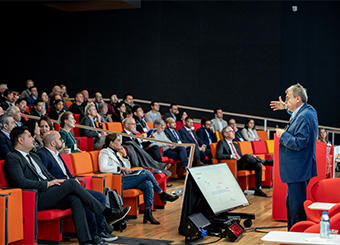 “Real-world problems do not have [clear-cut] labels — global warming is not just physics, or engineering, or mathematics. Medicine is not just biology, chemistry, or computer science,” said Bertsimas, the Boeing Professor of Operations Research and associate dean of business analytics at MIT. “Multi-modal data will increasingly be used across science, engineering, and medicine, and [AI] will become the predominant methodology for predictions and decision-making across all fields.”
“Real-world problems do not have [clear-cut] labels — global warming is not just physics, or engineering, or mathematics. Medicine is not just biology, chemistry, or computer science,” said Bertsimas, the Boeing Professor of Operations Research and associate dean of business analytics at MIT. “Multi-modal data will increasingly be used across science, engineering, and medicine, and [AI] will become the predominant methodology for predictions and decision-making across all fields.”
At Harvard, cross-disciplinary teams are leveraging machine learning to identify patients whose social determinants of health put them more directly in the path of climate-change-related impacts and a bevy of other risks to oral health.
“Are exposures to wildfires impacting oral health? If they become more frequent, who’s most vulnerable and how do we act on this information?” asked Francesca Dominici, director of the Harvard Data Science Initiative at the T.H. Chan School of Public Health.
 She and a team of researchers are using AI to analyze satellite data, atmospheric chemistry models, and other factors, revealing which communities are most affected by increasingly frequent wildfires, extreme heat waves, and destructive storms. Reduced air quality from fires and higher temperatures from warming climate can cause mouths to be drier, making people more prone to oral disease and tooth decay. Increased psychological stress from extreme weather events can increase risk for teeth grinding and temporomandibular joint (TMJ) disorders.
She and a team of researchers are using AI to analyze satellite data, atmospheric chemistry models, and other factors, revealing which communities are most affected by increasingly frequent wildfires, extreme heat waves, and destructive storms. Reduced air quality from fires and higher temperatures from warming climate can cause mouths to be drier, making people more prone to oral disease and tooth decay. Increased psychological stress from extreme weather events can increase risk for teeth grinding and temporomandibular joint (TMJ) disorders.
What’s more, “natural disasters can disrupt access to dental facilities and care,” Dominici added.
Augmenting — Not Replacing — Human Knowledge
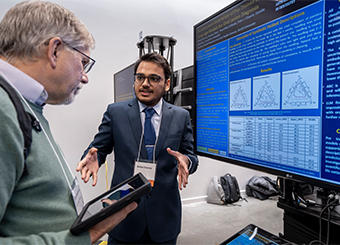 Biomedical researchers are also deploying AI to speed up and optimize experiments, therapeutic discovery, and pre-clinical validation. “[AI is] generating, acquiring, harmonizing, and refining data, and it can generate hypotheses, as well as simulate experiments and downstream outcomes,” said Marinka Zitnik, an assistant professor of biomedical informatics at Harvard Medical School.
Biomedical researchers are also deploying AI to speed up and optimize experiments, therapeutic discovery, and pre-clinical validation. “[AI is] generating, acquiring, harmonizing, and refining data, and it can generate hypotheses, as well as simulate experiments and downstream outcomes,” said Marinka Zitnik, an assistant professor of biomedical informatics at Harvard Medical School.
It will revolutionize the way therapies are matched individually to patients, she said, and help design entirely new drugs and therapeutics. A survey of 1,600 biomedical researchers revealed that 25 percent of them feel AI will be essential to their studies within the decade, Zitnik added.
She specializes in building knowledge graph AI models, which help contextualize and capture relationships within diverse sets of biomedical data. Her team has developed a knowledge graph AI model called TxGNN that describes 17,000 diseases using all available clinical and biomedical data. Once trained, it will be able to predict how well any given therapeutic might effectively treat a patient’s unique disease, and even be able to recommend new uses for FDA-approved medications.
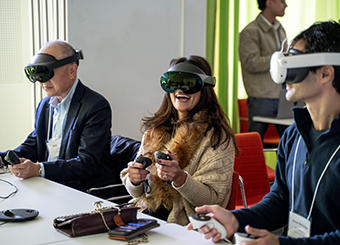 On the industry side of dental care, two primary types of AI-assistive technologies are already making waves in dentists’ offices: platforms for patients, providers, and payers that focus on using AI to interpret and analyze imaging, and AI software that automates patient engagement, scheduling, and other time-consuming “back office” tasks for dental practices.
On the industry side of dental care, two primary types of AI-assistive technologies are already making waves in dentists’ offices: platforms for patients, providers, and payers that focus on using AI to interpret and analyze imaging, and AI software that automates patient engagement, scheduling, and other time-consuming “back office” tasks for dental practices.
“AI [products] on the market today are not decision-makers, they are helpers,” said Phillippe Salah, co-founder and CEO of DentalMonitoring.
Dental AI tools include products that allow dentists to remotely analyze patient-submitted oral photos submitted via smartphone. Imaging tools use AI to guide patients as they capture images of their teeth, and then can detect signs of declining oral health to flag for the dental care team. AI-guided 3D simulations of patients’ mouths help orthodontists accelerate the fittings and transition between bracers, aligners, and retainers. Some tools even enable patients to see AI-powered, life-like simulations of how their teeth, mouth, and face will look after dental work or braces.
“One of the biggest frustrations in my practice was knowing what my patients needed, but not having the tools or ability to communicate that in a way [that inspired my patients to] to prioritize their dental care,” said Edward Zuckerberg who owns a private practice and is the chief dental officer at both Keystone Bio and Viome.
Several FDA-cleared AI products on the market today use visual dashboards to show patients and their dental care teams precisely where areas of decay are detected in the mouth and to what degree – motivating patients to pursue care sooner.
When AI and High Stakes Collide
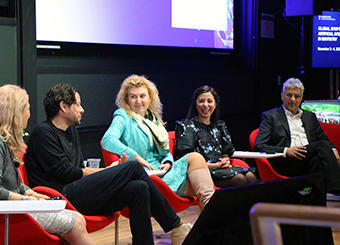 Although the upsides of AI are undoubtedly exciting, experts at the intersection of AI and dentistry agree that with progress must also come prudence.
Although the upsides of AI are undoubtedly exciting, experts at the intersection of AI and dentistry agree that with progress must also come prudence.
“I’m excited about the abundance of AI solutions [we’re talking about] here,” said Mariya Filapova, chief technology officer at CareQuest Innovation Partners. But, she cautioned, AI is not good at empathy, creativity, or imagination — all uniquely human factors that are critical to solving problems ethically.
And, she continued, new technologies are often put into play before guidelines and policy have caught up.
While more and more AI dental platforms are being cleared by the FDA for commercial access, that process “doesn’t regulate fairness and bias,” said Hawazin Elani, assistant professor of oral health policy and epidemiology at HSDM. “We have to own where our data [that’s training AI systems] is coming from.”
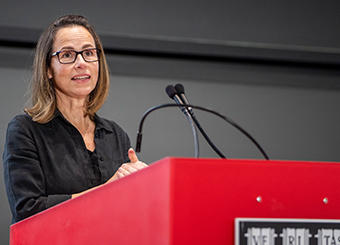 Fernanda Viégas of Harvard and Google, a keynote speaker at the symposium, warned that healthcare providers should not have to put blind faith in AI decision-making.
Fernanda Viégas of Harvard and Google, a keynote speaker at the symposium, warned that healthcare providers should not have to put blind faith in AI decision-making.
Viégas, a principal scientist at Google and the Gordon McKay Professor of Computer Science at Harvard’s John A. Paulson School of Engineering and Applied Sciences, and her collaborators at Google have found that clinicians are more likely to adopt AI tools that don’t spit out automated results without sharing details about its analytic framework or the baseline data the system was trained on.
“In high stakes situations” like making the correct diagnosis for a patient, Viégas said, “[we found] being able to engage with [AI] systems at meaningful levels mattered a lot” to healthcare providers. “It touches upon the need for trust, confidence, transparency… and these are all really hard things to accomplish [in an AI system]. As we start to deploy new [technologies], we will find these gaps [in user experience] that we need to design for.”
Giannobile, the dean of HSDM, couldn’t agree more with the need for continued alliance among researchers, practitioners, and industry as AI further transforms the field of dental medicine in coming years.
“This was our inaugural symposium on AI and dentistry, but we know things will change rapidly in this space – perhaps even within the next couple of weeks. So, stay tuned, because we’ll be inviting you back to meet again,” he said.
— Kat J. McAlpine, HSDM Correspondent
This article explores perspectives from artificial intelligence & dentistry experts who shared their insights as speakers at Harvard School of Dental Medicine’s recent Global Symposium on AI & Dentistry.


